 Featured: Selma dress
Featured: Selma dress
In many cases, discover your fabric as inspiration and the theme for the piece begins there. There are so many design ideas you can do with patterned fashion fabric and a bit of elastic. Take for instance, the Selma dress with an elasticized bodice and striking rope trim makes for a nautical style and fun back by Christopher Deane. Come across your own themed fabric and try this dress draft for summer.
You will need:
- approx. 2 ½ yds. [2.3m] of fashion fabric, 45″ [114 cm] wide (depends on desired length)
- shirring elastic thread.
- 4 yds. [3.6m] of cording, 1/2″ [12mm] diameter
- Coordinating thread
MEASUREMENTS
X = bust measurement (measure just under the arms around the fullest part of the chest).
Finished length = measure vertically from the armpit to the desired hemline .
PATTERN

This is a patternless design (simple block draft). Plot and cut block layout directly onto the fabric according to your measurements as illustrated (seam allowance is included).
CUTTING
Cut 1 front, cut 1 back, cut 4 bra cups and cut 4 loop carriers (1-1/2” [4 cm] wide strips).
ASSEMBLY
1. Make 2 self-lined bra cups. Begin by layering 2 pieces, with right sides together. Stitch across narrow top edge using ½” seam allowance. From machine stitching, measure down ½” and sew down both sides of bra piece, using ½” seam allowance. Press seams open; then turn bra cup right side out. Press bra cups flat and topstitch across the top of each bra cup below the openings. Baste the raw edges together. Set aside.
2.  With FACE side up, shirr fabric panels using elastic thread in the bobbin. Begin 1” from top edge of panel and stitch across width of each panel. Do parallel rows of shirring about ½” apart (I used the presser foot width as a guide) and continue until you have a shirred length of fabric equal to 1/3 X.
With FACE side up, shirr fabric panels using elastic thread in the bobbin. Begin 1” from top edge of panel and stitch across width of each panel. Do parallel rows of shirring about ½” apart (I used the presser foot width as a guide) and continue until you have a shirred length of fabric equal to 1/3 X.
For example: if the bust equals 36 inches , you would shirr 12-inch length from the top edge of the panel.
3. With right sides together, layer the fabric panels and align the shirred portions while matching the edges along the length. Pin or baste and stitch to create a tube, using ½” seam allowances. Press seams open.
Design Note: The fit of this style is not a snug one. The dress is designed to hang from the shoulder straps. You may get a closer fit by increasing the seam allowance at the side seams.
4. Hem the bottom edge of the tube with a narrow double rolled hem by turning under the bottom edge twice by ½” and press. Topstitch hemline.
5. On one panel front, find the center of the panel above the shirring and mark. Pin/baste one bra cup on either side of this mark, with right side facing. Sew across bottom edges of bra cups.
6. Make carriers 1/2″ X 3″ [12mm X 75mm]; you will need 4 of them. At the outer edges of the bra cups, fold a carrier in half to form a loop and secure to either side of the garment. Divide the back portion between the two loop carriers into thirds. Place a loop carrier at each location and secure.
7.  Serge or pink the raw edge of the top edge. Turn top edge to inside and press. Topstitch in place.
Serge or pink the raw edge of the top edge. Turn top edge to inside and press. Topstitch in place.
8. Cut 2 lengths of cording. Thread cord in each bra casing and gather up excess fabric to create the gathers. Knot cording together to create halter straps and thread through loop carriers.
 Featured: Best Behavior
Featured: Best Behavior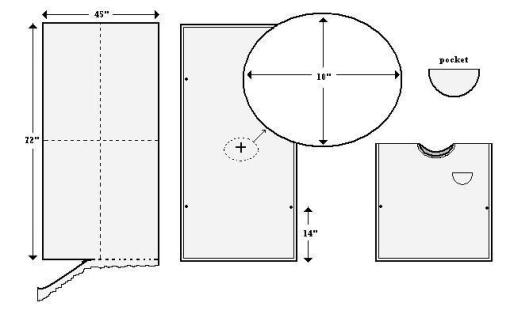

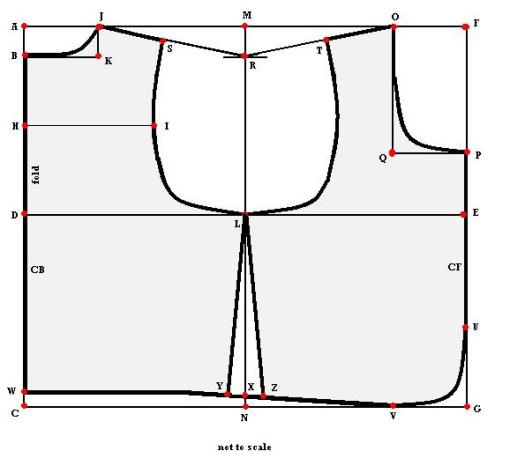
 Cut 2 bias strips 2 ½” wide [65mm] in lining fabric.
Cut 2 bias strips 2 ½” wide [65mm] in lining fabric. Featured: Victoria Secret Peasant Skirt
Featured: Victoria Secret Peasant Skirt
 You will cut 2 panels to make each tier. (skirt front & back).
You will cut 2 panels to make each tier. (skirt front & back).
 With right sides facing each other, sew the side seams together on each pair of panels using ½” [12 mm] seam allowance. Edge finish each of these seams with an
With right sides facing each other, sew the side seams together on each pair of panels using ½” [12 mm] seam allowance. Edge finish each of these seams with an  At this point, sew a narrow double-rolled hem around the entire bottom edge of the lower tier. Press up 1/2″ [12 mm], open the fabric back out, and press the raw edge in to meet the first crease. Sew the rolled hem.
At this point, sew a narrow double-rolled hem around the entire bottom edge of the lower tier. Press up 1/2″ [12 mm], open the fabric back out, and press the raw edge in to meet the first crease. Sew the rolled hem.

 Featured: Simplicity
Featured: Simplicity

 Cut BACK 1X self on fold
Cut BACK 1X self on fold Courtesy: Vogue
Courtesy: Vogue This pattern is drafted
This pattern is drafted  Dress Back – cut 1X self on fold
Dress Back – cut 1X self on fold Turn upper edge of dress down 1 inch to make a gathered ruffle, and baste. Apply the bias fold tape on top of the raw edge of the turned dress edge. At this time, place one shoulder strap under the top edge of the bias fold tape and locate it in the middle of the front pieces. Make a
Turn upper edge of dress down 1 inch to make a gathered ruffle, and baste. Apply the bias fold tape on top of the raw edge of the turned dress edge. At this time, place one shoulder strap under the top edge of the bias fold tape and locate it in the middle of the front pieces. Make a 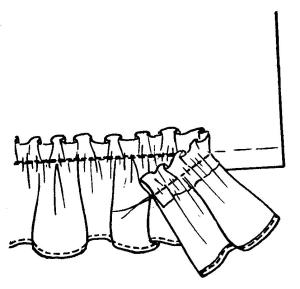 On the bottom of the dress, apply the flounce to the bottom edge.
On the bottom of the dress, apply the flounce to the bottom edge.  Featured: Rouge Passion Capelet by Giambattista Valli for Moncler.
Featured: Rouge Passion Capelet by Giambattista Valli for Moncler.
 Use a set-square to draw a 90 degree angle on the Kraft paper.
Use a set-square to draw a 90 degree angle on the Kraft paper.
 Back and Sleeve Insulation – cut 1X batting
Back and Sleeve Insulation – cut 1X batting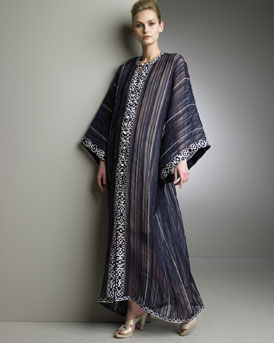 Featured: Oscar de la Renta Caftan
Featured: Oscar de la Renta Caftan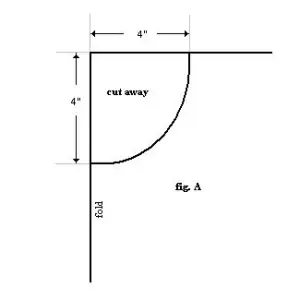 From the foldline at the center top edge of the fabric:
From the foldline at the center top edge of the fabric: Choose the other panel of fabric to be the back of the caftan. Spread it out on the tabletop, face side up, and fold in half lengthwise. Mark and cut the back neck opening as follows:
Choose the other panel of fabric to be the back of the caftan. Spread it out on the tabletop, face side up, and fold in half lengthwise. Mark and cut the back neck opening as follows: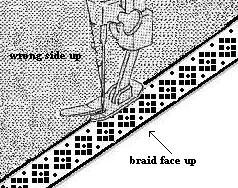 Align the edge of the flat braid to the foldline of the seam allowance. The trim should be on top of the seam allowance with wrong sides together.
Align the edge of the flat braid to the foldline of the seam allowance. The trim should be on top of the seam allowance with wrong sides together. 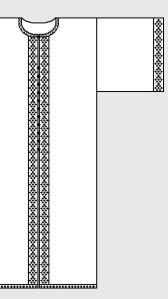 To complete the caftan:
To complete the caftan:

 Mark the center of each fabric piece.
Mark the center of each fabric piece.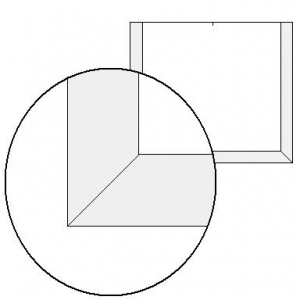 Pin/baste and sew each seam using ½” [1.25 cm] seam allowance. Press the seam allowances towards the lining. Turn this piece right side out.
Pin/baste and sew each seam using ½” [1.25 cm] seam allowance. Press the seam allowances towards the lining. Turn this piece right side out. Lay out the skirt with the hem away from you and the fashion fabric face up. Fold the fabric along its length so that the 2 sides meet at the center. Measure from the mitered corners 6″ [15.25 cm] and mark the location with a pin. This will be an open slit.
Lay out the skirt with the hem away from you and the fashion fabric face up. Fold the fabric along its length so that the 2 sides meet at the center. Measure from the mitered corners 6″ [15.25 cm] and mark the location with a pin. This will be an open slit. Topstitch 1/8″ [0.25 cm] along the fold of the top edge of the skirt.
Topstitch 1/8″ [0.25 cm] along the fold of the top edge of the skirt.